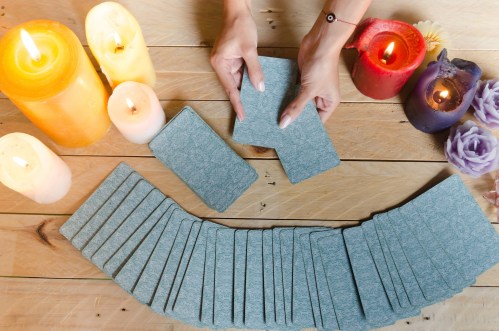Our editors independently select these products. Making a purchase through our links may earn Well+Good a commission
How to read your own tarot cards, no memorization necessary
Learning how to read tarot cards doesn't have to be daunting. Each card holds a different meaning, but it's possible to intuit that without memorizing.

I’m a big fan of learning about any and all woo-woo tools (sage, crystals, pendulums—you name it), and tarot cards definitely fall into that category. But when I first discovered them, I found them to be intimidating and overwhelming: There are 78 cards in a deck and each offers different meanings, and endless card combinations. Heck, even just shuffling the tarot cards can be tricky. And what if the scary-sounding death card comes up? So. Many. Questions.
Early on in my tarot adventures, I learned that though a lot of value and wisdom can be gleaned from the traditional meanings of the cards, memorizing each isn’t a requirement. Rather, the key for knowing how to read tarot cards rests with your intuition. And this makes sense considering that they’re tools for receiving and interpreting messages from our inner selves or the universe. So below, get readers’ top tips for learning how to read tarot cards for yourself intuitively, sans memorization.
The key rules for reading tarot cards without memorizing the meanings
Infuse the cards with your energy
Before you start pulling cards, spend some time with your tarot deck to infuse it with your energy. Kristine Fredheim, founder of Soul Cards, recommends giving them a good shuffle while thinking or saying your name and birth date. And to get super-intimate with your cards, you can also consider sleeping with them under your pillow.
Study the journey of the cards
While it’s certainly possible to learn how to read tarot cards without any memorization, it’s also helpful to at least understand the general journey of the cards before you jump in.
“If you completely disregard the traditional meanings and only go with your gut, you’ve missed the opportunity to tap into the deep wisdom of the cards,” says Brigit Esselmont, author of Everyday Tarot and founder of Biddy Tarot. “Traditional meanings help us to connect with the ancient wisdom and collective consciousness of the cards. And intuitive meanings help us to connect with our own inner voice and wisdom.” So ideally, you want a nice balance of the two.
There’s a shortcut to this, though. Here’s how to read tarot cards for yourself.
Below, find your 6-step guide to reading your own tarot cards
1. Understand the major arcana
The tarot deck is comprised of two main sections: The major arcana and the minor arcana. There are 22 major arcana cards, and each represents big life themes and has strong symbols that give you clues to the essence of the meaning. The sun card, for example, conjures a feeling of radiance and abundance, and the hermit points to spending time alone—and those tidbits are clear without knowing the background of any card.
2. And also the minor arcana
The minor arcana, on the other hand, focuses on the day-to-day themes of life, and these cards flow similarly to a deck of playing cards. There are four suits, and each has an ace through 10 card, plus four court cards (page, knight, queen, and king).
“One trick to learn the minor arcana is by laying out the cards, 1 to 10 (and the court cards), and looking at the numerical progression as a ‘journey,’ Fredheim says. “You can get creative and create a fictional story with each numbered card as a point in the journey.”
It’s also helpful to understand the theme of each suit: cups, swords, pentacles, and wands. Cups, Fredheim says, are all about emotions, feelings, and relationships. Swords relate to thoughts, communication, and mentality. Pentacles are about the physical world, health, and money. And wands represent creativity and passion.
3. Pull a card
Once your deck is infused with your energy and you have a general understanding of how they flow, it’s time to pull a card. If you’re a tarot newbie, Fredheim suggests doing a one-card pull to keep things super simple. “Start by laying down the cards and hovering your hand over them,” she says. “When you feel a little electricity in your finger, pick that card.”
4. Tell the story of the card
After picking a card, you can begin to tell its story. Esselmont recommends spending a moment analyzing what you see in the card. Notice the symbols. Who is in the card? What are they doing? What could have happened before or after the scene pictured in the card? How might the characters be feeling?
“Every card has a picture, and that picture tells a story and that story has a meaning,” Esselmont says. Once you’ve taken in all the imagery, you can ask yourself how this story relates to you and your life, and if there is an underlying meaning.
5. Pay attention to the intuitive hits
The next (and most important) step is to tap into your intuition to pick up what messages the card has for you based on the images, symbols, and story the card tells. Are there any feelings or emotions that pop up? “Remember, the first thought or feeling is always the right one,” Fredheim says. “Intuition speaks before ego, always.”
If all you hear is crickets when you’re listening for intuitive downloads, don’t worry. “If you get stuck, close your eyes, take a deep breath, then open your eyes and describe what you see,” Esselmont says. “Your intuition will gradually kick into gear, and you’ll find the deeper, personal meaning behind each card laid out in front of you.”
6. Trust yourself
“With the tarot, you’re being invited to reclaim your power and rediscover that the answers you seek are within,” Esselmont says. So, always trust yourself.
And like with all other pursuits in life, practice is key. “Everybody is intuitive,” Fredheim says. “It’s just like a muscle; the more you work at it, the stronger it gets.”
Here’s a tarot reader’s top tips for getting the most accurate reading. And if you’re curious about a different type of woo-woo practice? Try on toe reading for size.









